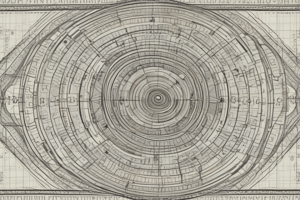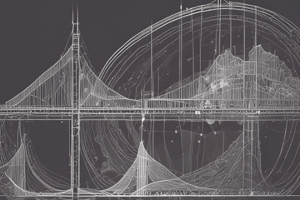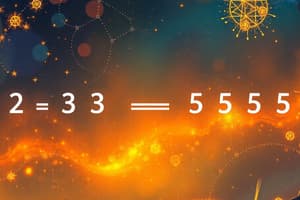Podcast
Questions and Answers
What is the simplest form of the decimal 0.75 as a fraction?
What is the simplest form of the decimal 0.75 as a fraction?
- 15/20
- 7/10
- 3/4 (correct)
- 1/2
Convert the decimal 0.2 into a fraction in its simplest form. What is the result?
Convert the decimal 0.2 into a fraction in its simplest form. What is the result?
- 2/10
- 2/5
- 1/5 (correct)
- 1/4
If you convert the decimal 0.125 into a fraction, what is its simplest form?
If you convert the decimal 0.125 into a fraction, what is its simplest form?
- 1/8 (correct)
- 5/40
- 3/24
- 1/4
Determine the simplest fraction form of the decimal 0.6.
Determine the simplest fraction form of the decimal 0.6.
What fraction represents the decimal 0.04 in its simplest form?
What fraction represents the decimal 0.04 in its simplest form?
What is the simplest fraction form of the decimal 0.9?
What is the simplest fraction form of the decimal 0.9?
Convert the decimal 0.56 into a fraction. What is the simplest form?
Convert the decimal 0.56 into a fraction. What is the simplest form?
What is the fraction representation of the decimal 0.03 in simplest form?
What is the fraction representation of the decimal 0.03 in simplest form?
Determine the fraction form of the decimal 0.125 in its simplest representation.
Determine the fraction form of the decimal 0.125 in its simplest representation.
Flashcards
Terminating Decimal
Terminating Decimal
A decimal that ends after a certain number of digits, for example, 0.5, 1.25, or 3.14.
Fraction
Fraction
A number that can be represented as a fraction where the numerator and denominator are both integers. For example, 1/2, 3/4, or 5/8.
Simplest Form
Simplest Form
Simplifying a fraction means dividing both the numerator and denominator by their greatest common factor (GCD) until they have no more common factors other than 1.
Decimal to Fraction
Decimal to Fraction
Signup and view all the flashcards
Greatest Common Factor (GCD)
Greatest Common Factor (GCD)
Signup and view all the flashcards
Simplifying a Fraction
Simplifying a Fraction
Signup and view all the flashcards
Converting a Terminating Decimal to a Fraction
Converting a Terminating Decimal to a Fraction
Signup and view all the flashcards
Study Notes
-
To convert a terminating decimal to a fraction, express the decimal as a numerator over a denominator.
-
The denominator should be a power of 10 (10, 100, 1000, etc.). The power of 10 corresponds to the number of decimal places.
-
Example:
- 0.5 is equivalent to 5/10
-
Simplify the resulting fraction to its lowest terms. This involves finding the greatest common divisor (GCD) of the numerator and denominator and dividing both by it.
- In this case, 5/10 simplifies to 1/2
-
Example:
- 0.25 = 25/100; simplified to 1/4
- 0.125 = 125/1000; simplified to 1/8
- 0.7 = 7/10
- 0.375 = 375/1000; simplified to 3/8
General Procedure
- Count the number of digits after the decimal point. This determines the power of 10 in the denominator.
- Write the digits after the decimal point as the numerator.
- Write the denominator as 10 raised to the power of the number of decimal places.
- Simplify the fraction to the lowest terms by dividing the numerator and the denominator by their greatest common divisor (GCD).
Examples with Detailed Steps
-
Convert 0.3 to a fraction:
- The decimal has one digit after the decimal point, so the denominator will be 10.
- The numerator is 3.
- The fraction is 3/10.
- The fraction is already in its simplest form.
-
Convert 0.12 to a fraction:
- The decimal has two digits after the decimal point, so the denominator will be 100.
- The numerator is 12.
- The fraction is 12/100.
- Simplifying, the GCD of 12 and 100 is 4. Dividing both by 4 gives the simplified fraction of 3/25.
-
Convert 0.16 to a fraction:
- The decimal has two digits after the decimal place.
- Construct a fraction with 16 in the numerator and 100 in the denominator (16/100).
- Find the GCD of 16 and 100. The GCD is 4.
- Divide both the numerator and denominator by the GCD: 16/4 = 4 and 100/4 = 25. This makes the converted fraction 4/25
Important Considerations
- Always simplify the fraction to its lowest terms. Failure to do so will result in an answer that isn’t expressed in its simplest form.
- The process is consistent for any terminating decimal.
- Write the fraction in its simplest form means writing the fraction with the lowest possible numerator and denominator values.
Studying That Suits You
Use AI to generate personalized quizzes and flashcards to suit your learning preferences.




